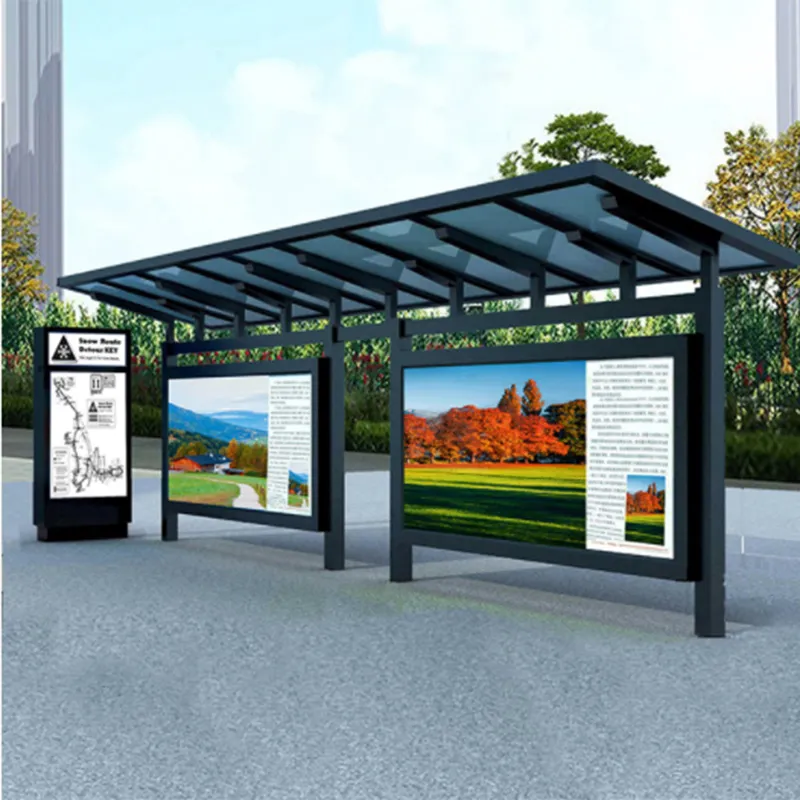- English
- Español
- Português
- русский
- Français
- 日本語
- Deutsch
- tiếng Việt
- Italiano
- Nederlands
- ภาษาไทย
- Polski
- 한국어
- Svenska
- magyar
- Malay
- বাংলা ভাষার
- Dansk
- Suomi
- हिन्दी
- Pilipino
- Türkçe
- Gaeilge
- العربية
- Indonesia
- Norsk
- تمل
- český
- ελληνικά
- український
- Javanese
- فارسی
- தமிழ்
- తెలుగు
- नेपाली
- Burmese
- български
- ລາວ
- Latine
- Қазақша
- Euskal
- Azərbaycan
- Slovenský jazyk
- Македонски
- Lietuvos
- Eesti Keel
- Română
- Slovenski
- मराठी
- Srpski језик
What materials are bus shelters made of?
2024-09-11
Bus shelters are typically made from a combination of durable, weather-resistant materials to ensure longevity, safety, and low maintenance. Common materials include:
1. Steel
- Galvanized Steel: Commonly used for the frame due to its strength and resistance to corrosion when coated.
- Advantages: Durable, strong, and able to withstand harsh weather conditions. Galvanization protects against rust.
- Usage: Often forms the main structural components, such as the roof support and frame.
2. Aluminum
- Advantages: Lightweight, rust-resistant, and requires minimal maintenance. It’s also recyclable and offers a sleek, modern appearance.
- Usage: Frequently used for the frame, roof, and paneling. Aluminum is favored in areas where weight is a concern, or for aesthetic reasons.
3. Glass or Polycarbonate
- Tempered Glass: This shatter-resistant glass is used for bus shelter walls and windows.
- Polycarbonate Panels: A durable, lightweight alternative to glass. It’s impact-resistant, UV-protected, and less likely to break.
- Advantages: Both materials allow visibility, provide protection from the elements, and add a modern look. Polycarbonate is often preferred for safety in vandal-prone areas.
- Usage: Installed in the side panels or back walls of the shelter for transparency and protection.
4. Plastic or Composite Materials
- Advantages: Lightweight, cost-effective, and resistant to corrosion. Often UV-stabilized to prevent fading from sunlight exposure.
- Usage: Used in roof panels, seating, or decorative elements. Composites offer flexibility in design while ensuring durability.

5. Wood
- Advantages: Eco-friendly and aesthetically pleasing. Treated wood can resist moisture, insects, and decay.
- Usage: Less common in urban settings but often used in more rural or aesthetic-conscious areas. It’s mainly used for benches or design elements.
6. Concrete
- Advantages: Strong, durable, and stable. It can also withstand heavy usage and vandalism.
- Usage: Often used for the foundation or in more robust shelters for added stability.
7. Stainless Steel
- Advantages: Corrosion-resistant, strong, and offers a polished, modern look. It’s also low-maintenance and can withstand extreme weather.
- Usage: Typically used in higher-end shelters or as support columns and for decorative finishes.
Key Considerations:
- Durability: Materials must withstand harsh outdoor conditions like rain, snow, and UV radiation.
- Maintenance: Low-maintenance materials, such as aluminum and polycarbonate, are favored in high-traffic areas.
- Vandal Resistance: In certain areas, materials like polycarbonate and tempered glass are used to reduce damage from vandalism.
- Aesthetic Appeal: Materials like aluminum, tempered glass, and wood are chosen for modern or eco-friendly designs.
In summary, bus shelters are made from a mix of steel or aluminum for the frame, glass or polycarbonate for visibility, and durable plastics, wood, or concrete for seating and other structural components. These materials balance strength, aesthetics, and maintenance requirements.
Ningbo Qixin Technology Co., Ltd is a high-tech private stock enterprise, engaged in industrial metal material processing..Visit our website at https://www.nbqixin-tech.com to learn more about our products. For inquiries, you can reach us at sales@nbqixintech.com.





